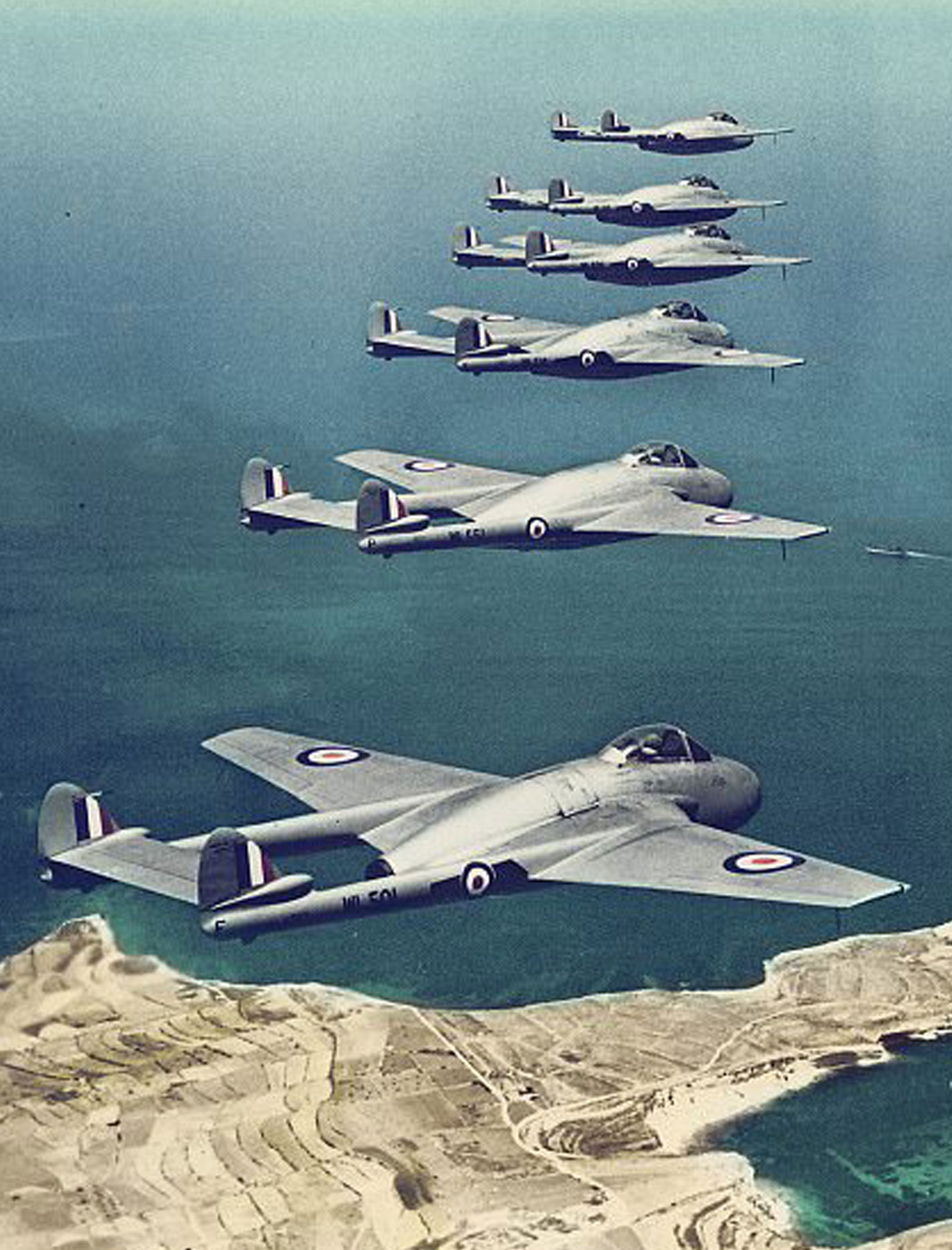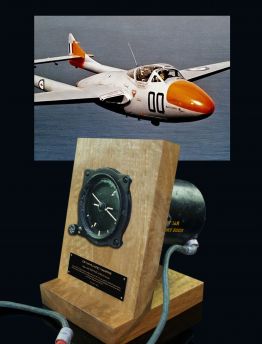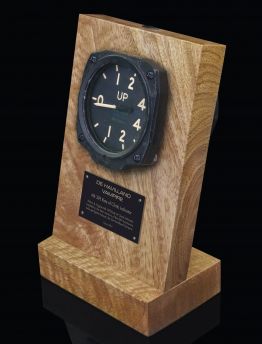- AUST POST SHIPPING
- 0438 654 235
- info@recoverycurios.com
- P.O. Box 7640 Cairns QLD Australia, 4870
-
0
Shopping Cart


DE HAVILLAND VAMPIRE JET
 By the closing months of the war in Europe, Britain had responded to the Luftwaffe's radical twin engine Me 262 jet fighter with their own sub sonic fighter, the Gloster Meteor.
By the closing months of the war in Europe, Britain had responded to the Luftwaffe's radical twin engine Me 262 jet fighter with their own sub sonic fighter, the Gloster Meteor.
Although it never saw air to air combat and only participated in a few ground attack missions, the Meteor heralded a new era in British aviation but it wasn't the only jet fighter being developed by the government at the time.
 In 1941, the De Havilland group had already commenced experimenting with a twin-boom and tail, single engine jet fighter, the De Havilland Vampire.
In 1941, the De Havilland group had already commenced experimenting with a twin-boom and tail, single engine jet fighter, the De Havilland Vampire.
Originally viewed as an experimental exercise, the single jet engine design was initially hampered by the lack of power delivered by the first generation of jet engines.
While Frank Whittle's ground breaking turbo jet engine design ultimately became the power source for the Gloster Meteor, it still needed two of them to keep it aloft.
 The development of the British Halford H.1 turbojet engine and its further refinement as the Goblin 1 turbojet delivered over 2700lbs of thrust - was a marked improvement over the original twin Gloster Meteor engines which barely delivered 17000lbs between them.
The development of the British Halford H.1 turbojet engine and its further refinement as the Goblin 1 turbojet delivered over 2700lbs of thrust - was a marked improvement over the original twin Gloster Meteor engines which barely delivered 17000lbs between them.
 Highly impressed by the new power plant, the British government placed an order with De Havilland for the mass production of the Vampire as the RAF’s new interceptor with the first entering operational service in late 1945.
Highly impressed by the new power plant, the British government placed an order with De Havilland for the mass production of the Vampire as the RAF’s new interceptor with the first entering operational service in late 1945.
Exploiting De Havilland’s extensive experience of moulded plywood aircraft construction, made famous by the highly successful high speed and streamlined wartime fighter/bomber the De Havilland Mosquito, the Vampire featured many of the same design principles as its predecessor, with the fuselage nacelle and vertical surfaces using the same moulded plywood construction.
 The Vampire’s single turbo jet engine sat directly behind the cockpit housed in an egg-shaped fuselage made up of a one piece moulded plywood body with an aluminium hood.
The Vampire’s single turbo jet engine sat directly behind the cockpit housed in an egg-shaped fuselage made up of a one piece moulded plywood body with an aluminium hood.
The twin booms and extended tail fins on either side of the engine considerably shortened the Vampires exhaust chamber providing superior thrust to other designs where thrust was lost due to the chamber running down the entire length of the aircraft’s fuselage to finally exit at the tail.
 The Vampire Mk 1 were equiped with four 20 mm Hispano Mk V cannons located beneath the nose and soon replaced the RAF’s ageing Hawker Typhoon and Tempests serving with RAF squadrons of the Second Tactical Air Force stationed in Germany.
The Vampire Mk 1 were equiped with four 20 mm Hispano Mk V cannons located beneath the nose and soon replaced the RAF’s ageing Hawker Typhoon and Tempests serving with RAF squadrons of the Second Tactical Air Force stationed in Germany.
It proved to be a very effective replacement for the RAF’s war-time turbo prop aircraft and went onto become the first jet aircraft to cross the Atlantic Ocean as well as the first jet engine to successfully complete a carrier launch and landing.
 By the end of 1946, the fifth generation Vampire fighter/bomber entered service with a vastly improved Goblin III engine, armour protections around the engine systems and a reenforced frame and extended undercarriage to handle greater take-off stresses and provide ground clearance for its added ordnance.
By the end of 1946, the fifth generation Vampire fighter/bomber entered service with a vastly improved Goblin III engine, armour protections around the engine systems and a reenforced frame and extended undercarriage to handle greater take-off stresses and provide ground clearance for its added ordnance.
Able to carry an external fuel tank or 500lb bomb under each wing and equipped with eight 3” rockets inboard of the modified swept-back wings at its peak, 19 RAF squadrons in the UK, Europe, the Middle East and the Far East operated the FB.5 with the largest contingent stationed in Germany in response to the emerging cold war conflict and events in Korea.
 Many Vampires saw active combat in the Far East during the Malayan Emergency in the late 40’s and early 1950s targeting insurgents operating in dense and remote jungle areas.
Many Vampires saw active combat in the Far East during the Malayan Emergency in the late 40’s and early 1950s targeting insurgents operating in dense and remote jungle areas.
Remaining in front-line service with the RAF until 1953 when it was reassigned to a more supportive role as a ground support and trainer, successive variants of the Vampire included the Royal Navy Sea Vampire with its large VB-shaped arrester, enlarged air brakes landing flaps and strengthened under carriage as well as the popular Vampire T.33 two-seater trainer.
Both variants were exported to a number of airforces across the globe including Egypt, Canada, Sweden and Australia.
 In late 1946, the Australian government secured a production licence to manufacture the Vampire at the Commonwealth Aircraft Corporation (CAC) based in Melbourne. During the later part of the war, the newly formed CAC had designed and manufactured the Australian Wirraway and CAC Boomerang as well as a producing small number of Bristol Beaufighters and 22 P-51 Mustangs under license.
In late 1946, the Australian government secured a production licence to manufacture the Vampire at the Commonwealth Aircraft Corporation (CAC) based in Melbourne. During the later part of the war, the newly formed CAC had designed and manufactured the Australian Wirraway and CAC Boomerang as well as a producing small number of Bristol Beaufighters and 22 P-51 Mustangs under license.
The first 3 aircraft entering service with the RAAF were British built F1, F2 and the later FB.5 variants with the F2 featuring the more powerful Rolls-Royce Nene jet engine rather than the standard Goblin.
 It turned out that the Nene engine required larger air intakes than the less powerful Goblin so an interim solution was to mount auxiliary intakes on top of the fuselage just behind the cockpit. It was a fatal mistake.
It turned out that the Nene engine required larger air intakes than the less powerful Goblin so an interim solution was to mount auxiliary intakes on top of the fuselage just behind the cockpit. It was a fatal mistake.
The extra intakes led to loss of elevator control resulting in the loss of three aircraft and their pilots in unrecoverable dives and all future Nene powered Vampires were quickly modified to relocate the intakes below the fuselage.
 The first Australian built Vampire took to the skies in June 1949 and was soon followed by another 56 more F3 variants with swept back wings and underwing armament hard points.
The first Australian built Vampire took to the skies in June 1949 and was soon followed by another 56 more F3 variants with swept back wings and underwing armament hard points.
 By the end of the CAC’s production run in late 1954, over 190 aircraft had been produced with 110 of these being the T.33 two-seater trainer.
By the end of the CAC’s production run in late 1954, over 190 aircraft had been produced with 110 of these being the T.33 two-seater trainer.
Like its single-seater brother, the two-seater Vampire DH.115 trainer cockpit pod was also constructed using moulded plywood with side-by-side seating and dual controls. It was a tight fit with student pilot and trainer sitting shoulder to shoulder. The benefit of the dual controls and side-by-side seating for pilot and instructor made the transition from turbo-prop to jet a lot easier.
In the early 19502, the RAN had been preparing for the arrival of  their new carrier launched strike fighters, the De Havilland Sea Venom and ordered five T3 Vampire trainers which were navalised and delivered to their air training base at Nowra NSW
their new carrier launched strike fighters, the De Havilland Sea Venom and ordered five T3 Vampire trainers which were navalised and delivered to their air training base at Nowra NSW
Piston-engine pilots doing a Vampire conversion needed to adjust to its turbojet and throttle control quirks. Anticipating power needs was essential as the Goblin engine took time to spool-up, and to avoid rapid throttle movements to prevent engine surge or a flame-out. However manoeuvring and control surface responses were good and aerobatics were always a pleasure although stopping on a tarmac taxiway or airstrip was discouraged as hot exhaust from the tailpipe could damage asphalt.
 The RAAF’s Vampire operations were conducted under the control of No 78 Wing comprising No 75 and 76 Squadrons with the Wing being sent to Malta in 1952 as part of the islands’s defences during the Arab Israeli tensions in the region. The Wing also took part in NATO exercises in Germany in 1954 which saw the end of single seater Vampire operations as the CAC were new well underway into production of the new CAC Sabre jet fighter.
The RAAF’s Vampire operations were conducted under the control of No 78 Wing comprising No 75 and 76 Squadrons with the Wing being sent to Malta in 1952 as part of the islands’s defences during the Arab Israeli tensions in the region. The Wing also took part in NATO exercises in Germany in 1954 which saw the end of single seater Vampire operations as the CAC were new well underway into production of the new CAC Sabre jet fighter.
The remaining two seater training variances continued at all the RAAF Operational Training Units across Australia until 1968 when they were replaced with the Macchi MB-326 jet trainer. Those operating with the RAN continued vampire operations until 1971.
Whilst seeing little or no combat action, the Australian CAC Vampires were an important and essential platform for RAAF pilots transitioning from turbo prop to jet aviation enabling them to adapt quickly to the more advanced future RAAF jet fighters such as the Sea Venom, CAC Sabre, Skyhawk and later F 111.
 All De Havilland Vampire instruments listed below come complete with a detailed, custom-built Scale Model of the De Havilland Vampire aircraft on its Magnetic Display Arm; Mango Wood Display Stand & Plaque, plus Printed Fact Sheet featuring photo of instrument in aircraft cockpit - as shown in this F-86 Sabre example here:
All De Havilland Vampire instruments listed below come complete with a detailed, custom-built Scale Model of the De Havilland Vampire aircraft on its Magnetic Display Arm; Mango Wood Display Stand & Plaque, plus Printed Fact Sheet featuring photo of instrument in aircraft cockpit - as shown in this F-86 Sabre example here:
Return to VINTAGE ORIGINAL AIRCRAFT INSTRUMENTS
- LAND
- SEA
- AIR
- VINTAGE ORIGINAL AIRCRAFT INSTRUMENTS
- HAWKER TYPHOON
- VICKERS WELLINGTON
- FAIREY GANNET
- RYAN ST-A SPORTS TRAINER
- DE HAVILLAND TIGER MOTH
- HAWKER HUNTER
- Mc DONNELL DOUGLAS KC-10 AERIAL TANKER
- SOPWITH CAMEL
- AIRCO DH.1 AND DH.2
- JUNKERS JU 87
- CURTISS C-46 COMMANDO
- HANDLEY PAGE HAMPDEN
- SUPERMARINE SEAFIRE
- B-25 MITCHELL BOMBER
- BRISTOL BLENHEIM
- ENGLISH ELECTRIC LIGHTNING
- HAWKER TEMPEST MkVI
- YAKOVELOV YAK - 3
- FOCKE-WULF FW190
- FOLLAND GNAT
- AIRSPEED OXFORD
- SHORT STIRLING
- AVRO ANSON
- DOUGLAS C-133 CARGOMASTER
- HANDLEY PAGE VICTOR BOMBER
- DE HAVILLAND SEA VENOM
- VICKERS VALIANT BOMBER
- DOUGLAS A-26 INVADER
- GRUMMAN S2F TRACKER
- SUPERMARINE SPITFIRE
- LOCKHEED P2-V NEPTUNE
- P-51 MUSTANG
- BRISTOL BEAUFIGHTER
- DE HAVILLAND MOSQUITO
- B-26 MARTIN MARAUDER
- P3 ORION
- DOUGLAS A-20 HAVOC
- P-39 AIRACOBRA
- AVRO SHACKLETON
- B-17 FLYING FORTRESS
- B-24 LIBERATOR
- MESSERSCHMITT BF-110
- MESSERSCHMITT BF-109
- BRISTOL BEAUFORT
- KAWASAKI Ki-45 (NICK) INTERCEPTOR
- C-130 HERCULES
- CAC BOOMERANG
- AVRO LANCASTER
- GRUMMAN F4F WILDCAT
- F4U VOUGHT CORSAIR
- WESTLAND LYSANDER
- P-47 REPUBLIC THUNDERBOLT
- NORTH AMERICAN T-6 TEXAN - HAVARD
- C-47 SKYTRAIN
- DOUGLAS SBD DAUNTLESS
- CAC WIRRAWAY
- PBY CATALINA
- P-40 WARHAWK
- FAIREY SWORDFISH
- P-38 LIGHTNING
- HAWKER HURRICANE
- CURTISS SB2C HELLDIVER
- GRUMMAN F6F HELLCAT
- SEAKING HELICOPTER
- SEAHAWK HELICOPTER
- DOUGLAS A4G SKYHAWK
- GRUMMAN TBF AVENGER
- HANDLEY PAGE HALIFAX
- DOUGLAS SKYRAIDER AE-1
- GLOSTER METEOR
- JUNKERS JU-88
- F-86 SABRE JET
- SHORT SUNDERLAND
- B-29 SUPER FORTRESS
- F-9F GRUMMAN PANTHER
- F-100D SUPER SABRE
- BELL UH-1 HUEY HELICOPTER
- AVRO VULCAN STRATEGIC BOMBER
- CANBERRA BOMBER
- DHC-4 CARIBOU
- BLACKBURN BUCCANEER
- DE HAVILLAND VAMPIRE JET
- HAWKER SEA FURY
- LOCKHEED HUDSON
- LOCKHEED EC-121 WARNING STAR
- SEPECAT JAGUAR
- HAWKER SIDDELEY NIMROD
- HAWKER SIDDELEY HARRIER
- ARADO AR 196
- VOUGHT OS2U KINGFISHER
- LOCKHEED ELECTRA
- NORTHROP P-61 BLACK WIDOW
- BOEING CH-47 CHINOOK
- LOCKHEED PV-1 VENTURA
- BOEING P26-A 'PEASHOOTER'
- Ilyushin Il-2 ‘Sturmovik’
- WESTLAND WESSEX
- FAIREY FIREFLY
- VINTAGE AVIATION COLLECTABLES
- VINTAGE COLLECTABLE MODEL AIRCRAFT KITS
- RETRO STYLE METAL AIRCRAFT COLLECTABLES
- VINTAGE ORIGINAL AIRCRAFT INSTRUMENTS





